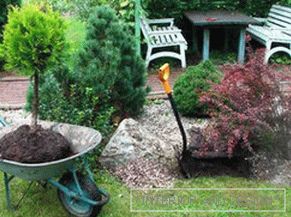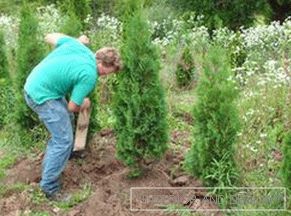 Thuja is an evergreen coniferous plant, which gardeners, landscape designers and gardeners are very fond of. It is able to decorate with itself any dacha, it is used to create a hedge. In addition, thuja produces aromatic essential oils.
Thuja is an evergreen coniferous plant, which gardeners, landscape designers and gardeners are very fond of. It is able to decorate with itself any dacha, it is used to create a hedge. In addition, thuja produces aromatic essential oils.
The tree is quite unpretentious, however, if it needs to be transplanted, then some caution should be exercised. It is recommended to do this in the fall, in September-October, so that it can settle down in a new place and prepare for winter. With the onset of spring, the plant begins to actively grow.
Content
- 1 Features of autumn transplant of thuja
- 1.1 Landing Subtleties
- 1.2 Ideal landing spot
- 2 How to transplant thuya?
- 3 Winter care for thuja
Features of the autumn thuya transplant
Landing details
To understand how to replant the plant in the fallIt is necessary to know certain details of landing during this period:
-
 it should be remembered that it is undesirable to plant this plant in the late fall, since inferior seedlings will not survive the upcoming cold weather;
it should be remembered that it is undesirable to plant this plant in the late fall, since inferior seedlings will not survive the upcoming cold weather; - The optimal time for transplantation is September-early October, before steady frosts occur, so that the roots can take root;
- the area around the stem of the plant can be filled with needles or compost - this will protect the roots from frost
- during heavy snowfalls, it is advisable to shake off snow from the needles, as the branches may break under its weight.
Ideal landing spot
 Thuja is considered a light-loving planttherefore, you need to choose a place where the plant will feel comfortable. In the shady area, it will also grow, but it will be rare and will lose all its decorative appeal and pomp. Thuja badly transfers drafts, therefore the place should be well protected from strong and cold winds.
Thuja is considered a light-loving planttherefore, you need to choose a place where the plant will feel comfortable. In the shady area, it will also grow, but it will be rare and will lose all its decorative appeal and pomp. Thuja badly transfers drafts, therefore the place should be well protected from strong and cold winds.
Plant the plant in an open area, alone or with other conifers, in the middle of a flower bed with annuals or in the center of the lawn. Everywhere it harmoniously fits and does not spoil the aesthetic representation.
Although thuja and soil resistantit is still better to choose a well-fertilized fertile soil. However, it also suits:
- sod, sandy land;
- loam.
If the soil is too heavy, a drainage should be arranged when planting so that moisture does not stagnate on the roots for too long.
If the roots are too long, they can be chopped off with shears or very sharp tools. After this place the cuts should be treated with putty, which is mixed with a solution of heteroauxin. It will prevent the reproduction of parasitic fungi.
Before you transplant thuja, the pit is plentifully watered. A mixture of sand, peat and sod land in the ratio 1: 2: 1 with the addition of coniferous litter and humus, which are mixed in equal proportions, is used as planting soil. Additionally add phosphorus-potassium fertilizers. It is necessary to ensure that this fertilizer does not fall on the root itself.
 When transplanting thuja, one should not bury the root neck too much, but it should not be left too high either. Finally, the soil around the trunk is compacted.after which the plant is watered. When transplanting an autumn thuja, it is necessary to cover the forest area with compost or wood chips, avoiding direct contact with the trunk.
When transplanting thuja, one should not bury the root neck too much, but it should not be left too high either. Finally, the soil around the trunk is compacted.after which the plant is watered. When transplanting an autumn thuja, it is necessary to cover the forest area with compost or wood chips, avoiding direct contact with the trunk.
All next month after transplantation, thuja is watered once a week and irrigates its crown. In winter, the plant should be covered, and the branches tied with string, so that they could not break under the weight of snow.
Winter care for thuja
In the first winter after transplantation, the plant is covered with burlap protecting it from sunburn and cold. Fabric materials are surely used because such coatings as:
- synthetics;
- polymer.
 Burlap should not be very tight, there must be air circulation, otherwise the thuja can be damaged during the thaw from drying out. So that the plant could survive the winter well, it is fertilized with special substances.
Burlap should not be very tight, there must be air circulation, otherwise the thuja can be damaged during the thaw from drying out. So that the plant could survive the winter well, it is fertilized with special substances.
The root system of the tree is insulated with leaves that are sprinkled with earth on top.. Fallen leaves can not only keep warm well, but also retain moisture, and if it starts to rot, the soil composition improves and enriches it with mineral substances.
Thus, any difficulties are not transplanted thui in the autumn. Considering all the subtleties and nuances, you can be sure that the plant will take root well and easily transfer the first winter, and in the summer it will be pleasing to the eye with its decorative appeal and pomp.



